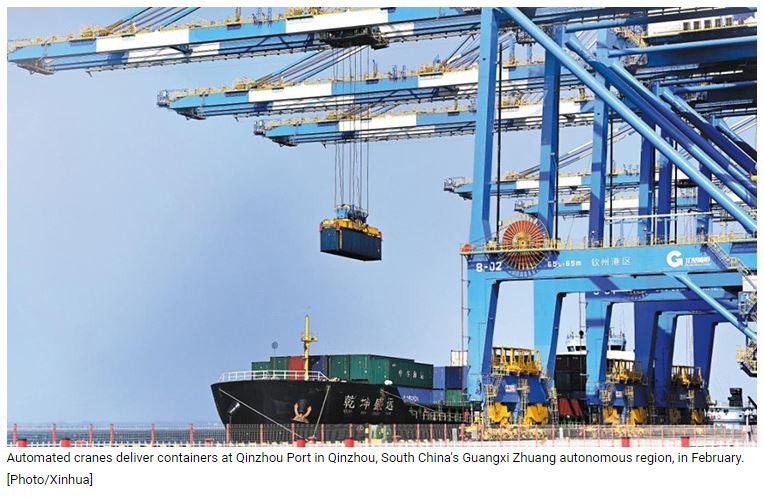Trade corridor boosts RCEP regional economic integration
Cargo ships carrying 18 tons of Orah mandarin oranges departed from Qinzhou Port, a part of Beibu Gulf Port in Guangxi Zhuang autonomous region, in late March, marking the very first batch of the sweet fruit exported via this sea route.
With the support of cold chain logistics, the local delicacy of Nanning, capital of Guangxi, is expected to reach Thailand in about eight days.
China’s fruit exports have grown sharply with the development of such cold chain logistics. Since the beginning of this year, Beibu Gulf Port has shipped about 2,850 twenty-foot equivalent units of freezers, including 500 TEUs of fresh fruit, said He Jian, project manager of a logistics company at the port.
“There are various transport means for Thai durian to enter the Chinese market. The increasingly convenient transportation and logistics network allows more ASEAN commodities to enter China and share market opportunities,” said Nisachol Thaithong, a Thai trader.
Thanks to the constant construction of the New International Land-Sea Trade Corridor, a trade and logistics passage jointly built by provincial-level regions in inland China and ASEAN members, Beibu Gulf Port plays a pivotal role in providing maritime transportation with large transport volumes and lower costs, efficiently helping meet consumption needs.
Huang Jiangnan, head of a railway station at the port, said that more varieties of China’s specialties, including goji berry products from the Ningxia Hui autonomous region, nuts from the Xinjiang Uygur autonomous region and tea from Guizhou province, have been exported using the corridor’s rail-sea intermodal services over the years.
Once little-known, the local signature products have become new driving engines of China’s foreign trade growth in the region, especially after the Regional Comprehensive Economic Partnership took effect on Jan 1, 2022.
The RCEP has also facilitated imports of commodities like Thai glutinous rice, Vietnamese basa fish and Cambodian bananas. On March 22, more than 5,700 cattle arrived at Beibu Gulf Port after a 17-day voyage from Australia. After a required 45-day quarantine, the cattle will be sold to help improve breeding and milk production across China.
With booming trade, the total number of rail journeys via the corridor’s rail-sea intermodal service surged from 178 in 2017, when the service began to operate regularly, to 8,820 last year. More high-end products with higher added value, like automobiles, are riding high on the trade corridor.
Since 2022, Beibu Gulf Port has launched specific foreign trade routes covering destinations in RCEP countries. The port currently has 34 shipping routes to ports in RCEP countries and plans to develop more goods source markets in countries like Thailand, Cambodia and Vietnam, said port authorities. Last year alone, Chinese goods to RCEP countries transported via the trade corridor grew 9.7 percent year-on-year to 69,000 TEUs.
Hello Chuxing, a Shanghai-based bike-sharing startup, recently announced an investment of about 1.2 billion yuan ($174.6 million) in future business expansion in ASEAN countries.
“The implementation of the RCEP enables enterprises to enjoy preferential tax rates for their exports, helping our market expansion in Southeast Asia,” said Liu Tao with the company.
With China’s accelerated opening-up and development, the trade corridor is expected to further promote the economic growth of the RCEP region in the future, said Lei Xiaohua, deputy director of the Institute of Southeast Asian Studies under the Guangxi Academy of Social Sciences. China Daily


 Thailand
Thailand




